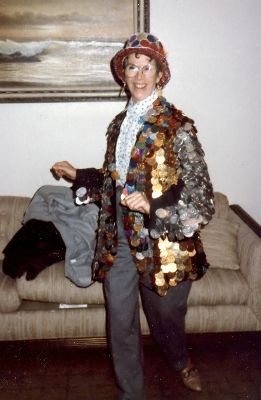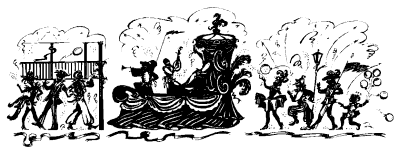
Julia, Mardi Gras, New Orleans, 1978
The celebration goes back to an ancient Roman custom of merrymaking before a period of fasting. In modern times the holiday precedes, for Catholics, the days when certain foods or habits will be given up for Lent, in recognition of the sacrifice which Jesus made of his life for the salvation of man.
In New Orleans, the street parades begin two weeks before Mardi Gras. Societies called Krewes pay for these and other festivities. Their members take to the streets in fancy dress and masks. On Shrove Tuesday, beautiful floats and marching bands climax the Carnival. Elaborate balls, by invitation only, are given during the two week period, and a king of Mardi Gras is crowned. The celebration in New Orleans has become so famous that it attracts visitors from all over the world.
 Julia, Mardi Gras, New Orleans, 1978 |
My brother, John, lived in New Orleans after he got out of the Army following World War Two. He had married a girl in Germany and by the time of my recollections they had four boys. John had for several years invited me to come and experience the Mardi Gras celebrations. I talked it over with my good friend, Derrell, and in 1974 we decided to go. She was quite adventurous and was in the habit of making trips alone or with one of her children. This, however, was the first long driving trip I had made without my husband.
Early on the morning of takeoff Derrell appeared in her big, black automobile (brand name I've forgotten), and away we went. She let me know that she had in the trunk several quarts of freshly squeezed grapefruit juice, which she had read was energizing and would help to keep us awake. We decided that we would trade driving every one hundred miles and would have a glass of juice at that time. So, without further problems, we were in Houston by afternoon, wide awake and sloshing with juice, where we spent the night with her son, Lonnie. The next morning we were on the road by 4:00 AM. We thought that by getting out before sunrise we would miss the early morning traffic. Big mistake! In Houston there is always lots of traffic, and, at the time we chose, the highway was clogged with huge trucks delivering all the produce necessary to keeping a large metropolis supplied. With heart in mouth and sweaty hands, and me driving for the first time in such congestion, we cleared Houston by daylight.
Late afternoon found us in Metairie, which is a parish near New Orleans and where we were to spend our second night, with my cousin Opal. Shortly after our arrival, she said it was time to see our first parade. We learned that each parish has its own parade during the two weeks before Lent. The most noticeable thing I saw as we stood on the parade route was that some of the viewers had six foot ladders with seats on top. As I watched, little children climbed the ladders and had a ringside seat. The neighborhood parade was comprised of marching bands and various floats put together by organizations in the area. This was not a long parade, and we had dinner with Opal and her husband, Herbert, before going downtown to New Orleans. I recall that it was almost freezing and I couldn't understand what would be so important to bring out the enormous crowds. In spite of the weather, there was a holiday spirit, and everyone huddled together to stay warm. As the floats came by, we were showered with round metal objects (doubloons) of different colors with pictures embossed upon them. Also bead necklaces and cheap trinkets were thrown by the people riding on the floats. The shivering people scrambled to get as many of these objects as possible, with everyone vying to get the most. Since Derrell and I were new to the game, we didn't get many.
The next day we went on to John's in Saint Bernard Parish. We then had an example of southern hospitality. My stepmother, Naida, lived in the upstairs of John's house. So she had invited her friends. John and Anna, his wife, had invited their friends as well, to meet us and have a chicken barbecue, which John prepared on his outdoor grill. As each person or couple arrived, we were introduced as John's sister and her friend. Each time we were kissed on both cheeks and welcomed effusively.
Later in the afternoon, arrangements were made to take two long tables and two cars to be parked fronting the parade route for the next day. I questioned this and was told that in order to get a good viewing advantage it was necessary to leave the cars the night before. It was a point of honor that no one bothered these preparations. The next morning, a tremendous amount of food was prepared - ham, several different kinds of salad, chicken, drinks of several kinds - all packed up with ice chests, plates, and cups. This was taken to where the cars were parked and, sure enough, all along the route there was a long line of cars and tables safely in place. Then came another big surprise. The two long tables were upended and arranged near our spot and long tablecloths draped over, with a big pot put inside so, lo and behold, we had a private toilet. I then noticed that, all up and down the parade route, similar edifices were concocted. Some had used a bit of ingenuity and used tents, or other odd looking facilities, but all for the same purpose. I laughed about this, but, since we were there for most of the day, it was soon obvious how welcome and practical the custom was. In such an immense crowd there would have been no way we could have gotten out to go to a more conventional place.
Our food was spread out on the hoods of the cars to be easily accessible, and all during the long day it was like a movable feast, with plenty of drinking, some alcoholic, to toast the event. In this parade there were many marching bands, lots and lots of floats, and cars and trucks decorated for the occasion. It is the custom for people, for weeks before Mardi Gras, to go to used car lots and buy most anything that is cheap and would keep moving for the length of the parade. They take these derelicts and cut the backs out, then decorate in marvelous examples of fanciful creativity. Then whole families, or groups of friends, ride in these, all the while throwing out the doubloons, beads, and whatever they can afford to buy. I never got up the courage to scramble for things, but my nephews, being seasoned veterans, got many and gave some to Derrell and me. I had heard of the big parades in downtown New Orleans but had never known of this more personal way of celebrating. It is as though the very expensive parades downtown are out of the reach of the common folk, so they have evolved their own way of having fun. My brother told me that an ordinance had been passed some years before that every float on this hours-long parade had to have a restroom on board. This too became an interesting point, to guess which part of the float was disguised as the "necessary."

By late afternoon, when the parade was winding down, I was told it was time to go to New Orleans to see the final really big event. The floats in all the local parishes were judged, and the best went downtown for the culmination of Mardi Gras.
No trip to Mardi Gras is complete without making a tour of the French Quarter and Bourbon Street. This is the old part, and it is indeed different. I'm sure there is a concerted effort to keep it without change as a tourist attraction. Here we saw transvestites in ball gowns and every outlandish costume imaginable. There were raucous crowds in some extremely risqué outfits hanging over the balconies of the second floors of buildings throughout the French Quarter. Derrell and I had our pictures taken with some of the men in dresses and felt quite daring.
As the time for the evening final parade neared, we were exhausted and sitting on the curb some blocks away, wondering how we were to get the energy to last. What happened next was truly almost unbelievable. A group of people came by and told us they were too pooped and were going back to their hotel. They offered to give us ringside tickets to the bleachers opposite to where the parade would pause and the King and Queen of Carnival would drink a toast, the highpoint of the event. I think by that time only I, Derrell, Anna, and Naida had had the stamina to be there. Naturally we were overjoyed and somehow managed to go the extra few blocks to get to our "best seat in the house". It was a magnificent ending to an unforgettable experience.
The next day we went to a French bakery, where Derrell knew real French bread in the traditional long loaves were made. She bought enough to fill the trunk of the big car, to share with her Texas relatives who had lived in Louisiana while growing up. We also went to stores where people who believed in Voodoo could buy potions, such as for casting spells and exorcism. No trip could end without beignets (a small, round, fried confection rolled in powdered sugar) and chicory coffee. Replete with full tummies and minds whirling with a kaleidoscope of memories, we left for our trip back to Texas.
Derrell and I were to take several more delightful trips, and I gained confidence in my ability to negotiate strange highways and cities. On a later trip across country and into Canada, we remarked one morning that "today we aren't going to get lost" and Russell, Derrell's nine year old grandson who was with us said, "Oh, you'll find a way." We did, but it was lots of fun.
(Many thanks, Julia, for this quite interesting and entertaining memoir!)